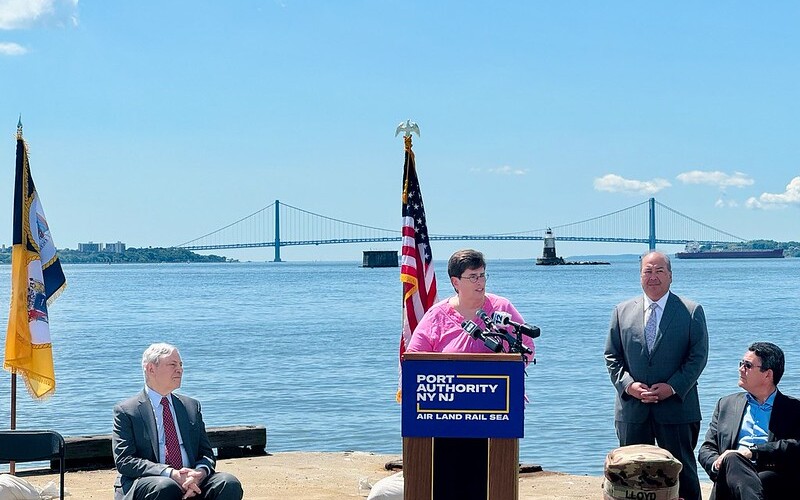Some $50 million in spending is lined up for berth maintenance dredging, berth rehabilitation and berth reconstruction in the Port of New York and New Jersey. An additional $32 million will go to deepening the Gravesend Anchorage, said port and Army Corps of Engineers officials.
The Gravesend project will deepen and widen the anchorage outside the Kill van Kull waterway, from its current depth of 47’ to 50’. That will allow big container ships to anchor between the Ambrose Anchorage in the Atlantic Ocean and the seaport’s container terminals, according to the Port Authority of New York and New Jersey.
Anchorage space closer to container terminals will improve safety and efficiency, allowing vessels “to move closer to the port during inspections, refueling or inclement weather and to have an emergency refuge area in the event of a mechanical or navigational issue,” according to an agency summary.
“For about 50 million people across several states, this port is the reason why we have food to eat, shoes on our feet and beds to go to sleep,” said Port Authority Chairman Kevin O’Toole during a May 29 press conference announcing the plan. “The port is the economic foundation on which the region is built, and now we’re strengthening that foundation even further with millions of dollars of investment alongside our longtime partners at the U.S. Army Corps of Engineers.”
The Port of NY/NJ handles $200 billion annually in cargo, and is the nation’s second busiest after Los Angeles/Long Beach, Calif. Port authority officials say NY/NJ handled “cargo volumes that ranged from nearly 19 percent to more than 47 percent above the amount of cargo handled before the (Covid-19) pandemic.”
“Our gateway’s flexibility and efficiency have enabled us to absorb an unprecedented cargo surge during the pandemic and lend a helping hand when disaster struck the Francis Scott Key Bridge in Baltimore,” said Port Authority Executive Director Rick Cotton. “The port’s success is built upon our partnership with the Army Corps of Engineers, and we thank them for their longtime support of the Port of New York and New Jersey.”
Those cargo trends are going to continue, said Bethann Rooney, director of the Port Authority’s ports division.
“These projects will make it possible for our seaport to serve a region whose demand for products made overseas is steadily increasing” said Rooney. “The levels of cargo growth we saw during the pandemic will return as the new normal, and we – along with everyone in the supply chain – must prepare now for that future.”
The Port Authority and Army corps began working on deepening the harbor channels in 1989, with a $2.1 billion effort to deepen the Kill van Kull and Newark Bay channels to 50’. Already seen then as critical to keeping the port competitive.
The agencies were also forced to contend with the legacy of contaminated harbor sediments, including dioxin and other toxins, after environmental activists and New Jersey officials pushed for years to end ocean disposal of sediment.
A quarter-century of those efforts culminated in raising the roadway of the Bayonne Bridge to allow 215’ of vertical clearance over the Kill van Kull channel, ensuring that container terminals would be accessible to the latest generation of 14,000 TEU containerships.
Port Authority planners “expect the seaport’s cargo volumes to double or triple by 2050, as forecasted in the seaport’s capital and operating improvements blueprint known as Port Master Plan 2050.”
“Our collaboration with the Port Authority, the states of New York and New Jersey, and the U.S. Coast Guard is essential in ensuring the port remains competitive and capable of handling large container vessels that help drive our nation’s supply chain and spur economic growth,” said Michael Connor, assistant secretary of civil works of the U.S. Army Corps of Engineers. “This plan is a major priority for the Biden administration and sets forth a consensus vision and strategy for future ecosystem restoration in the region that, in concert with our navigation improvements to come, will ensure the Port of New York and New Jersey remains a premier port for the years to come.”





